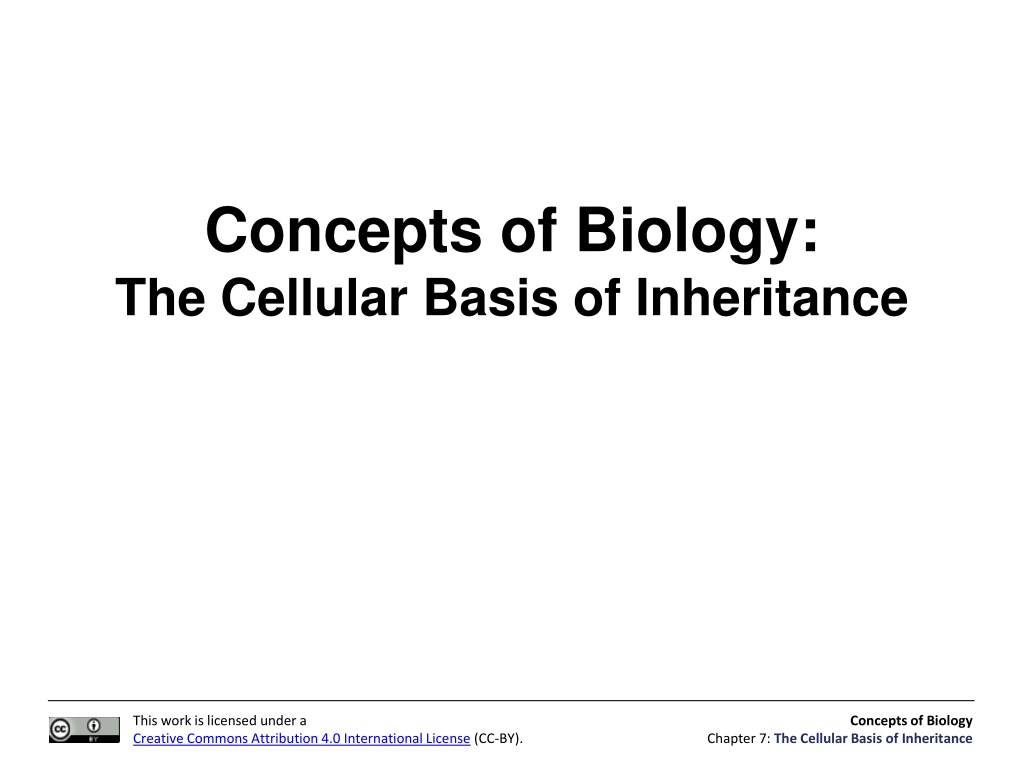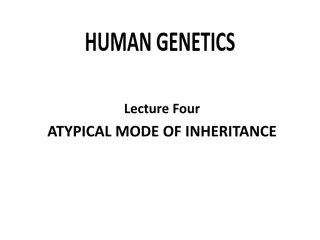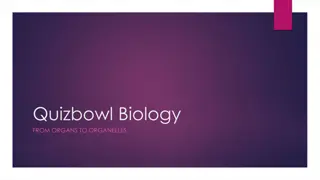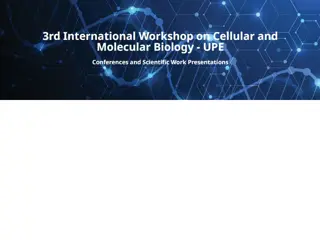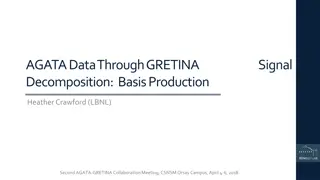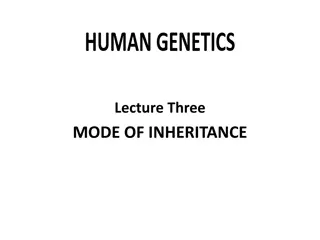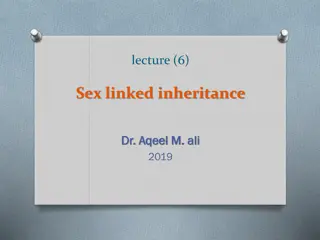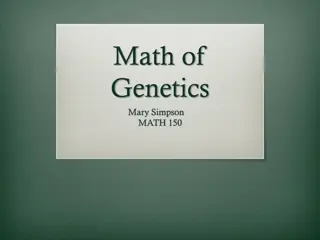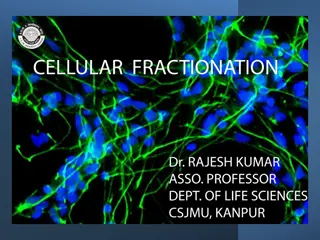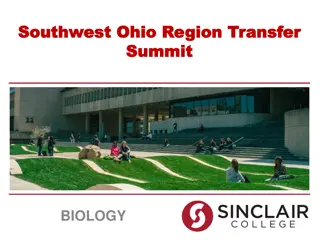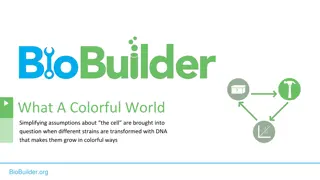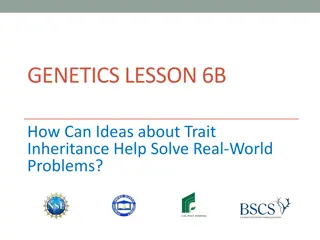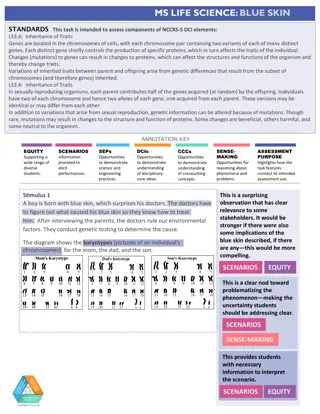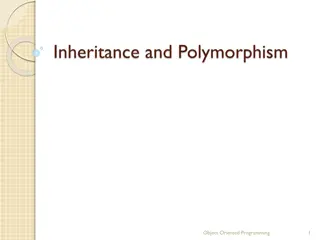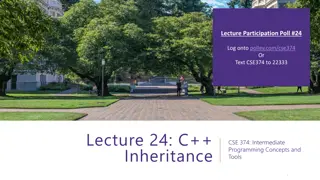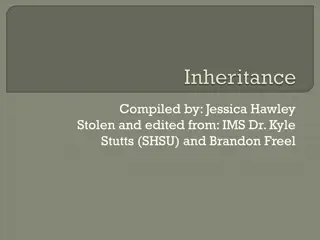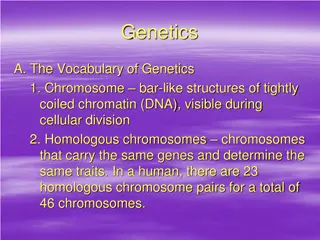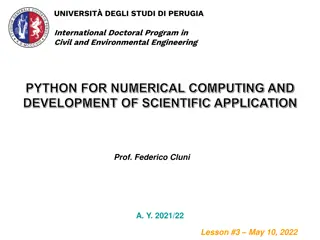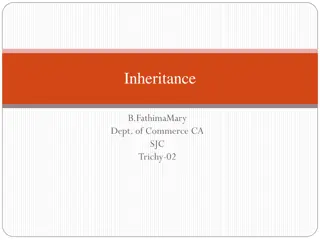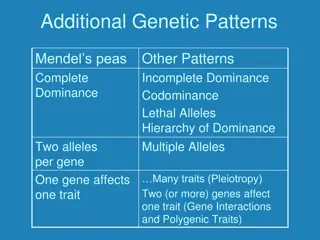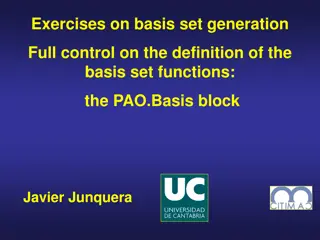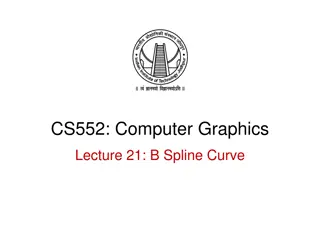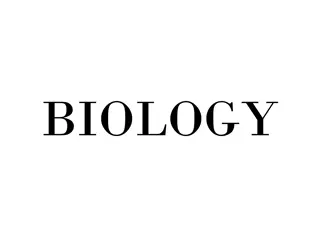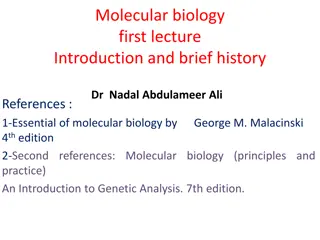The Cellular Basis of Inheritance in Biology
Understanding the significance of meiosis and sexual reproduction, this chapter delves into how multicellular organisms develop from a single fertilized egg through trillions of cell divisions. Exploring the necessity for genetic variation and the difference in reproductive strategies among organisms, it emphasizes the fundamental role of meiosis in creating genetic diversity for evolutionary success.
Download Presentation

Please find below an Image/Link to download the presentation.
The content on the website is provided AS IS for your information and personal use only. It may not be sold, licensed, or shared on other websites without obtaining consent from the author. Download presentation by click this link. If you encounter any issues during the download, it is possible that the publisher has removed the file from their server.
E N D
Presentation Transcript
Concepts of Biology: The Cellular Basis of Inheritance This work is licensed under a Creative Commons Attribution 4.0 International License (CC-BY). This work is licensed under a Creative Commons Attribution 4.0 International License (CC-BY). Concepts of Biology Creative Commons Attribution 4.0 International License Chapter 7: The Cellular Basis of Inheritance
Each of us, like these other large multicellular organisms, begins life as a fertilized egg. After trillions of cell divisions, each of us develops into a complex, multicellular organism. (credit a: modification of work by Frank Wouters; credit b: modification of work by Ken Cole, USGS; credit c: modification of work by Martin Pettitt) This work is licensed under a Creative Commons Attribution 4.0 International License (CC-BY). This work is licensed under a Creative Commons Attribution 4.0 International License (CC-BY). Concepts of Biology Creative Commons Attribution 4.0 International License Chapter 7: The Cellular Basis of Inheritance
Meiosis and sexual reproduction Every eukaryote, from yeast to you, uses meiosis to create gametes and is at the core of sexual reproduction. Why does this process predominate? Why don t organisms just clone themselves? Reproduce asexually? This work is licensed under a Creative Commons Attribution 4.0 International License (CC-BY). This work is licensed under a Creative Commons Attribution 4.0 International License (CC-BY). Concepts of Biology Creative Commons Attribution 4.0 International License Chapter 7: The Cellular Basis of Inheritance
Meiosis and sexual reproduction Cloned organisms are uniformly susceptible. Evolutionarily successful organisms need variation to buffer against the changing nature of the environment. The mixing of parental genes is what meiosis accomplishes for each new generation This work is licensed under a Creative Commons Attribution 4.0 International License (CC-BY). This work is licensed under a Creative Commons Attribution 4.0 International License (CC-BY). Concepts of Biology Creative Commons Attribution 4.0 International License Chapter 7: The Cellular Basis of Inheritance
In animals, sexually reproducing adults form haploid gametes from diploid germ cells. This work is licensed under a Creative Commons Attribution 4.0 International License (CC-BY). This work is licensed under a Creative Commons Attribution 4.0 International License (CC-BY). Concepts of Biology Creative Commons Attribution 4.0 International License Chapter 7: The Cellular Basis of Inheritance
Fungi, such as black bread mold (Rhizopus nigricans), have haploid-dominant life cycles. This work is licensed under a Creative Commons Attribution 4.0 International License (CC-BY). This work is licensed under a Creative Commons Attribution 4.0 International License (CC-BY). Concepts of Biology Creative Commons Attribution 4.0 International License Chapter 7: The Cellular Basis of Inheritance
Plants have a life cycle that alternates between a multicellular haploid organism and a multicellular diploid organism. (credit c fern : modification of work by Cory Zanker; credit c gametophyte : modification of work by Vlmastra /Wikimedia Commons) This work is licensed under a Creative Commons Attribution 4.0 International License (CC-BY). This work is licensed under a Creative Commons Attribution 4.0 International License (CC-BY). Concepts of Biology Creative Commons Attribution 4.0 International License Chapter 7: The Cellular Basis of Inheritance
Meiosis Meiosis occurs in germ tissue (e.g. testes and ovaries). Meiosis is reductional DNA is copied once and divided twice so that the products of the second division are haploid gametes. (e.g. sperm and eggs) The process ensures mixing and new combinations will be produced. This work is licensed under a Creative Commons Attribution 4.0 International License (CC-BY). This work is licensed under a Creative Commons Attribution 4.0 International License (CC-BY). Concepts of Biology Creative Commons Attribution 4.0 International License Chapter 7: The Cellular Basis of Inheritance
This work is licensed under a Creative Commons Attribution 4.0 International License (CC-BY). This work is licensed under a Creative Commons Attribution 4.0 International License (CC-BY). Concepts of Biology Creative Commons Attribution 4.0 International License Chapter 7: The Cellular Basis of Inheritance
Crossing Over In the previous illustration of the effects of crossing over, the blue chromosome came from the individual s father and the red chromosome came from the individual s mother. Crossover occurs between non-sister chromatids of homologous chromosomes. The result is an exchange of genetic material between homologous chromosomes. The chromosomes that have a mixture of maternal and paternal sequence are called recombinant and the chromosomes that are completely paternal or maternal are called non-recombinant. This work is licensed under a Creative Commons Attribution 4.0 International License (CC-BY). This work is licensed under a Creative Commons Attribution 4.0 International License (CC-BY). Concepts of Biology Creative Commons Attribution 4.0 International License Chapter 7: The Cellular Basis of Inheritance
Variation Crucial to this mixing is crossing over in Prophase I. After homologues find each other and perfectly pair, random portions are exchanged. It is impossible to create gametes identical to the gametes that created you. This work is licensed under a Creative Commons Attribution 4.0 International License (CC-BY). This work is licensed under a Creative Commons Attribution 4.0 International License (CC-BY). Concepts of Biology Creative Commons Attribution 4.0 International License Chapter 7: The Cellular Basis of Inheritance
This work is licensed under a Creative Commons Attribution 4.0 International License (CC-BY). This work is licensed under a Creative Commons Attribution 4.0 International License (CC-BY). Concepts of Biology Creative Commons Attribution 4.0 International License Chapter 7: The Cellular Basis of Inheritance
Independent Assortment Synapsed homologous pairs orient randomly on the metaphase plate after Prophase I This behaviour results in independent assortment Along with crossing over, it is the source of new genetic combinations This work is licensed under a Creative Commons Attribution 4.0 International License (CC-BY). This work is licensed under a Creative Commons Attribution 4.0 International License (CC-BY). Concepts of Biology Creative Commons Attribution 4.0 International License Chapter 7: The Cellular Basis of Inheritance
CONCEPT IN ACTION http://openstaxcollege.org/l/animal_ meiosis2 Review the process of meiosis, observing how chromosomes align and migrate, at the site (link above). This work is licensed under a Creative Commons Attribution 4.0 International License (CC-BY). This work is licensed under a Creative Commons Attribution 4.0 International License (CC-BY). Concepts of Biology Creative Commons Attribution 4.0 International License Chapter 7: The Cellular Basis of Inheritance
In prometaphase I, microtubules attach to the fused kinetochores of homologous chromosomes. In anaphase I, the homologous chromosomes are separated. In prometaphase II, microtubules attach to individual kinetochores of sister chromatids. In anaphase II, the sister chromatids are separated. This work is licensed under a Creative Commons Attribution 4.0 International License (CC-BY). This work is licensed under a Creative Commons Attribution 4.0 International License (CC-BY). Concepts of Biology Creative Commons Attribution 4.0 International License Chapter 7: The Cellular Basis of Inheritance
This work is licensed under a Creative Commons Attribution 4.0 International License (CC-BY). This work is licensed under a Creative Commons Attribution 4.0 International License (CC-BY). Concepts of Biology Creative Commons Attribution 4.0 International License Chapter 7: The Cellular Basis of Inheritance
CONCEPT IN ACTION http://openstaxcollege.org/l/how_cel ls_dvid2 For an animation comparing mitosis and meiosis, go to the site (link above). This work is licensed under a Creative Commons Attribution 4.0 International License (CC-BY). This work is licensed under a Creative Commons Attribution 4.0 International License (CC-BY). Concepts of Biology Creative Commons Attribution 4.0 International License Chapter 7: The Cellular Basis of Inheritance
This karyogram shows the chromosomes of a female human immune cell during mitosis. (credit: Andreas Bolzer, et al) This work is licensed under a Creative Commons Attribution 4.0 International License (CC-BY). This work is licensed under a Creative Commons Attribution 4.0 International License (CC-BY). Concepts of Biology Creative Commons Attribution 4.0 International License Chapter 7: The Cellular Basis of Inheritance
Autosomes vs. Sex chromosomes All humans have 22 pairs of autosomes Females have a pair of X chromosomes and males an X and a Y chromosome. This work is licensed under a Creative Commons Attribution 4.0 International License (CC-BY). This work is licensed under a Creative Commons Attribution 4.0 International License (CC-BY). Concepts of Biology Creative Commons Attribution 4.0 International License Chapter 7: The Cellular Basis of Inheritance
Errors in meiosis The orchestration of the process of meiosis is complex and often fails. ~50% of spontaneous abortions and miscarriages are thought to have their origins in meiotic mistakes. Nondisjunction is the name for failures in meiosis. This work is licensed under a Creative Commons Attribution 4.0 International License (CC-BY). This work is licensed under a Creative Commons Attribution 4.0 International License (CC-BY). Concepts of Biology Creative Commons Attribution 4.0 International License Chapter 7: The Cellular Basis of Inheritance
This work is licensed under a Creative Commons Attribution 4.0 International License (CC-BY). This work is licensed under a Creative Commons Attribution 4.0 International License (CC-BY). Concepts of Biology Creative Commons Attribution 4.0 International License Chapter 7: The Cellular Basis of Inheritance
Nondisjunction Mistakes can happen in either division. In both males and females, nondisjunction seems to increase with age. Nearly always, extra or missing chromosomes are fatal during embryogenesis. However, an extra copy of chromosome 21 (Down syndrome) and X and Y are tolerated. This work is licensed under a Creative Commons Attribution 4.0 International License (CC-BY). This work is licensed under a Creative Commons Attribution 4.0 International License (CC-BY). Concepts of Biology Creative Commons Attribution 4.0 International License Chapter 7: The Cellular Basis of Inheritance
The incidence of having a fetus with trisomy 21 increases dramatically with maternal age. This work is licensed under a Creative Commons Attribution 4.0 International License (CC-BY). This work is licensed under a Creative Commons Attribution 4.0 International License (CC-BY). Concepts of Biology Creative Commons Attribution 4.0 International License Chapter 7: The Cellular Basis of Inheritance
CONCEPT IN ACTION http://openstaxcollege.org/l/down_s yndrome2 Visualize the addition of a chromosome that leads to Down syndrome in this video simulation (link above). This work is licensed under a Creative Commons Attribution 4.0 International License (CC-BY). This work is licensed under a Creative Commons Attribution 4.0 International License (CC-BY). Concepts of Biology Creative Commons Attribution 4.0 International License Chapter 7: The Cellular Basis of Inheritance
Embryonic inactivation of one of two different X chromosomes encoding different coat colors gives rise to the tortoiseshell phenotype in cats. (credit: Michael Bodega) This work is licensed under a Creative Commons Attribution 4.0 International License (CC-BY). This work is licensed under a Creative Commons Attribution 4.0 International License (CC-BY). Concepts of Biology Creative Commons Attribution 4.0 International License Chapter 7: The Cellular Basis of Inheritance
X Chromosome Inactivation Males have one X chromosome and females have two. In early development, females randomly shut down one of their X chromosomes leading to a mosaicism that can be detected in a calico cat. This work is licensed under a Creative Commons Attribution 4.0 International License (CC-BY). This work is licensed under a Creative Commons Attribution 4.0 International License (CC-BY). Concepts of Biology Creative Commons Attribution 4.0 International License Chapter 7: The Cellular Basis of Inheritance
This individual with cri-du-chat syndrome is shown at various ages: (A) age two, (B) age four, (C) age nine, and (D) age 12. (credit: Paola Cerruti Mainardi) This work is licensed under a Creative Commons Attribution 4.0 International License (CC-BY). This work is licensed under a Creative Commons Attribution 4.0 International License (CC-BY). Concepts of Biology Creative Commons Attribution 4.0 International License Chapter 7: The Cellular Basis of Inheritance
An (a) inversion occurs when a chromosome segment breaks from the chromosome, reverses its orientation, and then reattaches in the original position. A (b) reciprocal translocation occurs between two nonhomologous chromosomes and does not cause any genetic information to be lost or duplicated. (credit: modification of work by National Human Genome Research Institute (USA)) This work is licensed under a Creative Commons Attribution 4.0 International License (CC-BY). This work is licensed under a Creative Commons Attribution 4.0 International License (CC-BY). Concepts of Biology Creative Commons Attribution 4.0 International License Chapter 7: The Cellular Basis of Inheritance
LTS activity http://outreach.letstalkscience.ca/componen t/zoo/item/diy-activities-2.html?Itemid=652 This work is licensed under a Creative Commons Attribution 4.0 International License (CC-BY). This work is licensed under a Creative Commons Attribution 4.0 International License (CC-BY). Concepts of Biology Creative Commons Attribution 4.0 International License Chapter 7: The Cellular Basis of Inheritance
